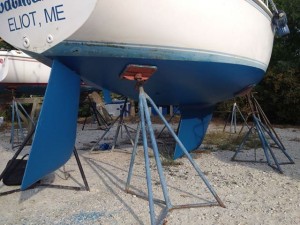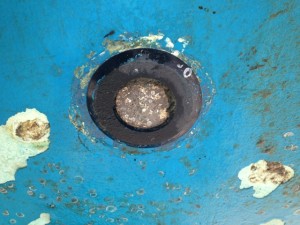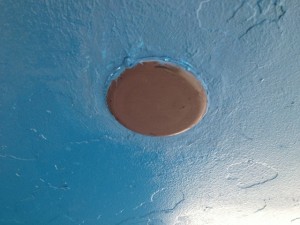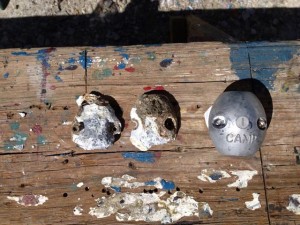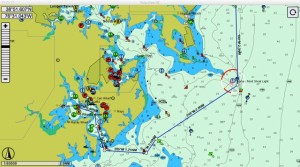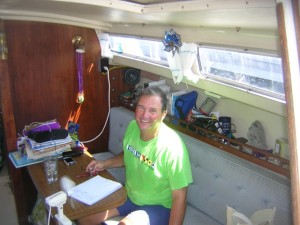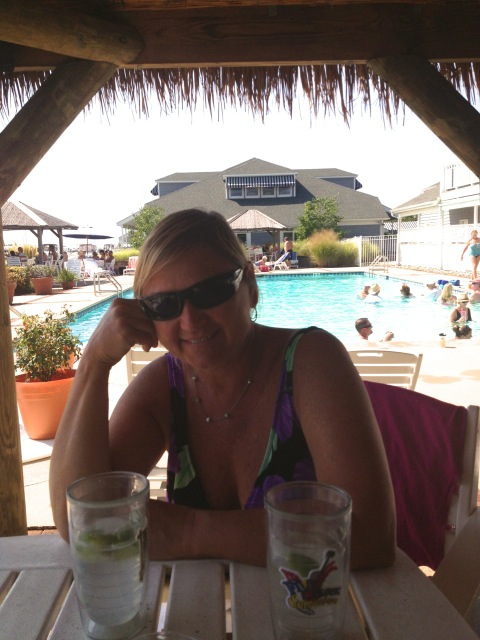Getting the Boat Ready to Sail
Ships carry boats. Since little Catnip the Dinghy follows us around everywhere we go, does that make Catmandu a ship?
Catmandu is a 1982 white-hulled Catalina 27, tall rig, with a striking royal blue dodger and sail cover, and a trusty inboard Atomic 4 gasoline engine. She is equipped with a gps chart plotter, depth sounder, new VHF radio with … and yes, a broken cassette deck. She has been in the water in Back Creek, Annapolis, MD for three years without a haul out. There were just a few things to do before we could sail south.
Hull – If you haven’t had your breakfast, you might want to look away. This picture shows what happens if you neglect your bottom and leave it hanging in the water for three years. Even the barnacles had barnacles. After a haul out, power wash and vacuum sanding, her bottom got three coats of bottom paint. It looks beautiful, as Phil says, if you don’t get too close.
Depth Sounder – The depth sounder started dozing off several months ago, usually when we were in shallow water and really needed it. The helpful readout would look like this: – – Occasionally, it would wake up in the middle of the Chesapeake and register something around 434 feet. With the boat’s underside exposed during her haul-out, it was easy to see why the instrument was so confused.
Zinc – I am not sure what this part is for, but I can see clearly that Catmandu needed a new one:
Engine – The inboard Atomic 4 and I have a history. This particular model of gasoline engine has stranded me four times in the past six years. Once in Narragansett Bay, twice just northwest of Block Island, Rhode Island, and once in the Severn River, Maryland. Two of those malfunctions involved the oil pressure safety valve. It’s a safety feature, so I am grateful that the engine didn’t start, burst into flames and sink the boat. In all cases, there were no fatalities and I ended up home safe. All the engine needed this week was a tune up, a water pump and some new spark plugs.
VHF Radio – The new radio is equipped with Digital Selective Calling (DSC) which allows it to transfer information in digital format to the Coast Guard in case of distress. Part of the alert is a nine-digit Maritime Mobile Service Identity (MMSI) number that identifies the boat. I had never heard of a MMSI number before, but I’m so glad now that we have it. MMSI is pronounced “mimsy”, as in, “All mimsy were the borogroves, and the mome raths outgrabe.”
Joker Valves – When Phil said he was replacing the joker valves in the head, I told him it made me feel like I was being laughed at every time I went in there. He assured me they were there to make the laughing gulls laugh. Another UGH picture, and then I’m done:
Dinghy – Every once in a while when we are underway, Phil looks astern at the dinghy and says, “Try to keep up, Catnip!” Once, Catnip decided to let go in the middle of the Chesapeake. Impulsively, the captain jumped overboard to recover the wayward dink, forcing the first mate to slow the boat (ship?) and circle back to pick them up. Catnip has been firmly attached ever since. The backup oars and the thwart have a new coat of varnish, and the little outboard motor purrs.
Catmandu is equipped and ready to go next week. Friday morning, Phil will weigh anchor and sail solo, eleven miles south to Edgewater, Maryland. I will fly from New Hampshire to BWI, catch the GO Shuttle at the airport and try to catch up with Phil and Catmandu at the Seven Seas Cruising Association Cruisers’ Gam. It’s the beginning of an adventure with an uncertain destination, unknown duration and a fluid timetable that is dependent on weather, water depth, tides and wind. But we know Catmandu is ready to sail.
Okay, Catnip, you can come, too. Hold on tight.

